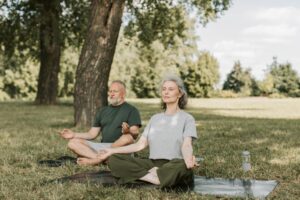What is 4-7-8 Breathing?
The 4-7-8 breathing technique is a simple and effective breathing exercise designed to promote relaxation and reduce stress. It was popularized by Dr. Andrew Weil, a well-known physician who emphasizes the power of breath for healing. This technique involves taking a deep breath in for 4 counts, holding it for 7 counts, and then exhaling slowly for 8 counts. By practicing this controlled breathing pattern, you can activate the body’s relaxation response, which helps calm the nervous system and reduce anxiety.
How to Use 4-7-8 Breathing for Anxiety
The 4-7-8 technique is easy to learn and can be done anywhere, making it a great tool for managing anxiety. Here’s a step-by-step guide on how to practice it:
- Get Comfortable: Find a quiet, comfortable place where you can relax. Sit or lie down in a position that feels natural and at ease.
- Close Your Eyes: Closing your eyes helps reduce distractions and allows you to focus entirely on your breath.
- Inhale for 4 Counts: Begin by breathing in slowly through your nose for a count of four. Try to fill your lungs completely, allowing your abdomen to expand as you breathe in.
- Hold Your Breath for 7 Counts: After you’ve inhaled, hold your breath for seven counts. This step might feel a little challenging at first, but with practice, it becomes easier.
- Exhale for 8 Counts: Slowly exhale through your mouth for a count of eight. Try to release the air as slowly and completely as possible. The longer exhale helps activate your parasympathetic nervous system, which promotes relaxation.
- Repeat: Complete this cycle for four breaths, then pause. Over time, you can increase the number of cycles you do. You can practice this technique for several minutes, especially when you’re feeling anxious or stressed.
Source https://www.lung.ca/
How 4-7-8 Breathing Helps With Anxiety
When you’re anxious, your breathing tends to become shallow and quick, which can make anxiety worse. The 4-7-8 technique helps counteract this by slowing your breathing and encouraging deeper, more mindful breaths. This process helps calm the nervous system and reduces the physical symptoms of anxiety, such as a racing heart or shortness of breath.
By focusing on your breath and counting each phase (inhale, hold, exhale), the technique also helps redirect your attention away from anxious thoughts. This distraction helps you stay grounded in the present moment, which can make you feel less overwhelmed.
Benefits of 4-7-8 Breathing
- Reduces Stress: The deep, slow breathing activates the parasympathetic nervous system, which helps relax the body and mind, reducing stress levels.
- Promotes Calmness: By focusing on your breath, you break the cycle of negative or anxious thoughts, helping you feel more calm and centered.
- Improves Sleep: Practicing 4-7-8 breathing before bed can help you fall asleep faster by calming your mind and relaxing your body.
- Balances Emotions: Regular practice can help regulate your emotions by lowering cortisol (the stress hormone) and promoting a balanced mood.
- Easy and Accessible: This technique doesn’t require any special equipment or setting, making it an easy tool to use whenever you feel anxious, stressed, or overwhelmed.
The 4-7-8 breathing technique is a simple but powerful tool for reducing anxiety and stress. By slowing down your breath and focusing on each step, you activate your body’s natural relaxation response, which helps calm both your mind and body. It’s a practice that can be done anywhere, anytime, making it an accessible way to manage anxiety in everyday situations. Whether you’re feeling anxious, struggling to sleep, or just need to relax, 4-7-8 breathing can be a helpful technique to bring peace and calm to your day.


Leave a Reply